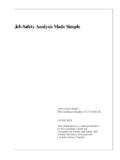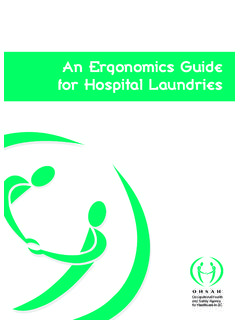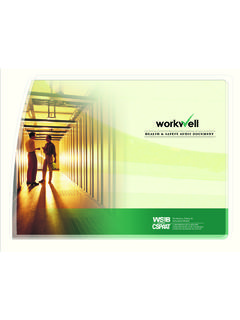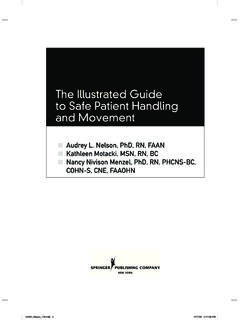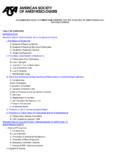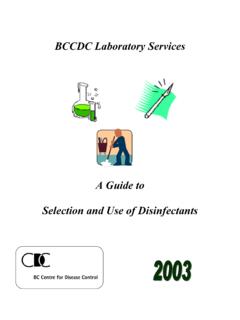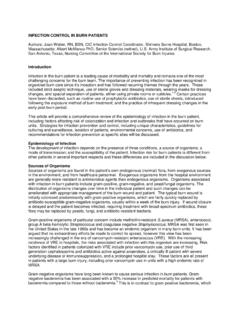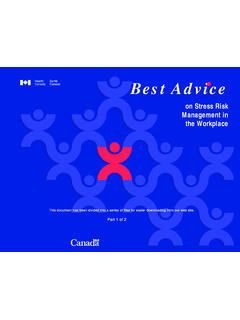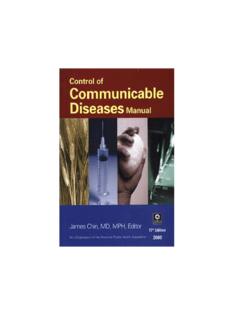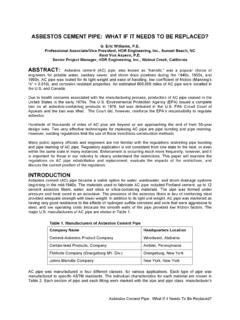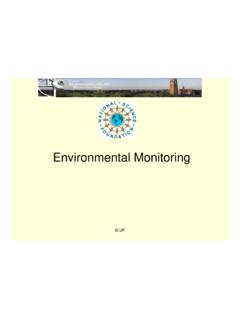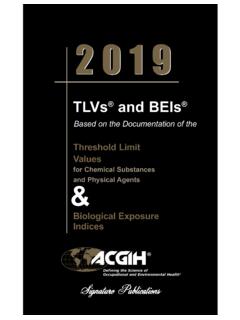Transcription of Calculations and Occupational Exposure Limits
1 Calculations and Occupational Exposure Limits Dr. Peter Bellin, PhD, CIH. EOH 466A. The Occupational Environment Definitions Vapors Gases Aerosols Particulates: dust, fume, fibers, nanoparticles, smoke Mist Particle size considerations Inspirable Particulate Mass (IPM). Thoracic Particulate Mass (TPM). Respiratory Particulate Mass (RPM). 2. Calculations Evaluation Control 1. OELs 3. OELs Concentration Parts per million Maximum vapor concentration = VPl / VPatm x 106. Milligrams per cubic meter Normal temperature and pressure 760 mm Hg and 25 C. Molar volume = Liters per mole 4. Calculations Evaluation Control 2. OELs Time-weighted average (TWA). Ceiling value (C). Short-Term Exposure Limit (STEL). Immediately Dangerous to Life and health (IDLH). 5. OELs Exposure Limits for gases and vapors are established in terms of ppm mg/M3 values are determined by calculation , conversion based upon an assumption of NTP.
2 If samples are taken at P and T conditions very different from NTP and results are in mg/M3, results must be corrected. 6. Calculations Evaluation Control 3. OELs Conversion between ppm and mg/M3. mg l X 3. Y ppm = M mole g MW. mole g Y ppm MW. mg mole X 3. =. M l mole 7. OELs Time weighted n C T. average concentration is i i measured by taking TWA = i =1. n one or more measurements of T. i =1. i concentration over a work shift. 8. Calculations Evaluation Control 4. OELs 8-hour TWA: average Exposure over an eight hour time period (normal work shift).. n CiTi 8 hour TWA = i =1. 8 hours 9. OELs Example: A press cleaner is monitored for Exposure to ethanol. The data are: Time Concentration Sample Period (ppm) Duration (number) (hours). 1 410 2 250 3 75 2. 10. Calculations Evaluation Control 5. OELs Sample TWA calculation 410 ppm + 250 ppm + 75 ppm 2hrs TWA =.
3 + + 2hrs 1640 ppm hrs = = 234 ppm 7 hrs 1640 ppm hrs 8 hr TWA = = 205 ppm 8hrs 11. OELs Short Term Exposure Limit (STEL). The concentration to which workers can be exposed continuously for a short period of time without suffering: Irritation Chronic or irreversible tissue damage Narcosis of sufficient degree to increase the likelihood of accidental injury, impaired self- rescue or materially reduce work efficiency 12. Calculations Evaluation Control 6. OELs Short Term Exposure Limits Usually a 15-minute period Should not be exceeded anytime during a workday, even if the 8-hour TWA is below the OEL. (8-hour TWA OEL will be a lower concentration). 13. OELs Short Term Exposure Limits Exposures above 8-hour OEL but below STEL. Should not be longer than 15 minutes Should not occur more than 4 times per day There should be at least 60 minutes between exposures in this range.
4 Example: diethylamine, TLV: 8-hour is 5 ppm. STEL is 15 ppm. 14. Calculations Evaluation Control 7. OELs Ceiling Value Concentration that should not be exceeded during any part of the work day. Designated by a C preceding substance listing. Example, Acetaldehyde, STEL = 25 ppm, and has a C' designation. 15. OELs Mixtures If the biological effects of a group of chemicals are independent, compare each Exposure to the OEL. If the ratio: 8-hour TWA / OEL is < 1 Exposure is below OEL. > 1 Exposure is above OEL. Do this for each chemical independently 16. Calculations Evaluation Control 8. OELs Additive effects Similar toxic effects sum the ratios of 8-hour TWA / OEL. K = sum of these ratios If K < 1, combined Exposure is below OEL. K > 1, combined Exposure is above OEL. 17. OELs Adjusting OELs to different work shifts Allowed Exposure should be changed to account for duration of Exposure OSHA model Brief and Scala Model 18.
5 Calculations Evaluation Control 9. OELs OSHA Model (T > 8 hours). 8 hrs TWA = PEL . T hrs 19. OELs Brief and Scala Model (T is shift in hours). 8 hrs 24 T hrs TLV = TLV. T hrs 16 hrs 20. Calculations Evaluation Control 10. OELs Example 1,2 trichloroethane (a solvent) has a biological half life of 16 hours. What modified PEL or TLV would be appropriate for people who work 3 12-hour shifts per week exposed to the compound? TLV and PEL are both 10 ppm 21. OELs Solution OSHA MODEL. 8 hrs PEL = 10ppm = 12 hrs Brief and Scala Model 8 hrs 24 12 hrs TLV = 10 = 5ppm 12 hrs 16 hrs 22. Calculations Evaluation Control 11. Evaluation and Control Dr. Peter Bellin, PhD, CIH. EOH 466A. The Occupational Environment Pre Inspection Research Before you visit, research the process. Learn some terms before visit. Look for records of previous inspections.
6 Become aware of hazards you might expect to see. 24. Calculations Evaluation Control 12. Initial Walk Through Observe work practices and environmental conditions. Look for evidence of potential safety and health hazards: dust, grime in air or on surfaces. Other signs? Observe operations: cutting, heating, mixing, bagging. Observe controls: engineering, administrative, personal protective equipment. Interview Workers: often have important and relevant information Make flow diagrams, notes, take photos if possible. 25. Basic Elements: Qualitative IH. Survey List locations covered by the survey. The elements of this list will depend on the size of the facility being evaluated as well as the level of evaluation. Description of operations. For each worksite (location) listed, list the operations conducted. This description should include some mention of the operations that may generate hazards.
7 List of hazardous materials. A list of materials used at each operation should also be listed. This list should be based on the material content, not the manufacturer: so if several suppliers of acetone are used, they can be counted together. List of hazardous physical agents. Sources of heat, noise, nonionizing radiation (microwaves), ionizing radiation, ergonomic hazards noted should be listed. Existing controls. Describe ventilation used, personal protection worn and administrative controls in place. Personnel information. Number and job titles of personnel working in the area should be collected. Comments from interviewed workers should be organized. 26. Calculations Evaluation Control 13. Quantitative IH Survey OSHA Inspection Exposure characterization Statistically reliable evaluation requires many measurements Sampling strategy is needed Design of survey will depend on a qualitative IH survey 27.
8 Quantitative IH Survey: How are Measurements Taken? Integrated over time: minutes to hours Grab sampling Size-selective sampling Direct reading instruments Colorimetric tubes Sampling media OSHA or NIOSH methods Accredited laboratory for analysis 28. Calculations Evaluation Control 14. Quantitative IH Survey: Record Keeping Minimum data elements Plant, location, date, worker ID, job titles, process name, time on/off, inspector name Document calibration and sample handling Provide a sound basis for future reference (legal proceedings?). Notify affected workers of monitoring results 29. Initial Design of Control Design Stage: Plan new construction, systems with worker protection in mind. Also consider: air pollution water pollution waste minimization hazardous waste control accident/disaster control 30. Calculations Evaluation Control 15.
9 Industrial Hygiene Control Once a system is constructed, methods to follow in correcting a problem. Priority of control substitution, process change ventilation/engineering administrative personal protection 31. Dilution Ventilation Also known as General Exhaust Ventilation substances of low toxicity. contaminant source large or diffuse. prevent buildup of explosive concentrations in a storage area. applies to gaseous hazards, not particulates. when local exhaust ventilation is not feasible. costs of clean air (make up air) not prohibitive. 32. Calculations Evaluation Control 16. Local exhaust ventilation Preferred with: substances of high toxicity unpredictable or sporadic generation point sources aerosols prevent pollution of air, water, etc. 33. Dilution Ventilation Theory Dilution ventilation may be applied in situations where vapor concentration build-up and decay can be predicted.
10 Assumptions when applying equations: perfect mixing in work area constant generation rate clean dilution air is used no other sources of product in air no other removal mechanisms than dilution 34. Calculations Evaluation Control 17. General Equation to Predict Concentration 1 ( t 2 t1 ) . Q . C2 = G - (G - QC1 )e V .. Q . Q = Volumetric flow of dilution air V = the room volume t = time C = concentration G = generation rate of vapor 35. Special Cases C1 = 0; t1 = 0; G > 0. G t . Q. C2 = 1 e V . Q . 36. Calculations Evaluation Control 18. Special Cases If a long time has passed, then exponent drops out (long is more than 3 air changes, Qt / V > 3). Cmax = G/Q. 37. Special Cases Concentration decay; no more generation. - Q. ( t 2 t1 ). C2 = C1e V. 38. Calculations Evaluation Control 19. Special Cases How much ventilation is needed to reduce concentration to safe levels?
